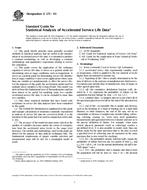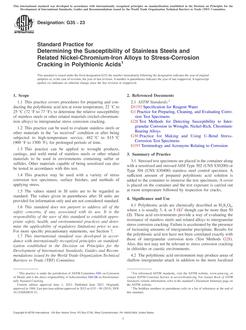
ASTM G172-03
1.1 This guide briefly presents some generally accepted methods of statistical analyses that are useful in the interpretation of accelerated service life data. It is intended to produce a common terminology as well as developing a common methodology and quantitative expressions relating to service life estimation.
1.2 This guide covers the application of the Arrhenius equation to service life data. It serves as a general model for determining rates at usage conditions, such as temperature. It serves as a general guide for determining service life distribution at usage condition. It also covers applications where more than one variable act simultaneously to affect the service life. For the purposes of this guide, the acceleration model used for multiple stress variables is the Eyring Model. This model was derived from the fundamental laws of thermodynamics and has been shown to be useful for modeling some two variable accelerated service life data. It can be extended to more than two variables.
1.3 Only those statistical methods that have found wide acceptance in service life data analyses have been considered in this guide.
1.4 The Weibull life distribution is emphasized in this guide and example calculations of situations commonly encountered in analysis of service life data are covered in detail. It is the intention of this guide that it be used in conjunction with Guide G 166.
1.5 The accuracy of the model becomes more critical as the number of variables increases and/or the extent of extrapolation from the accelerated stress levels to the usage level increases. The models and methodology used in this guide are shown for the purpose of data analysis techniques only. The fundamental requirements of proper variable selection and measurement must still be met for a meaningful model to result.
Product Details
- Published:
- 01/10/2003
- Number of Pages:
- 12
- File Size:
- 1 file , 430 KB

